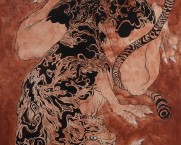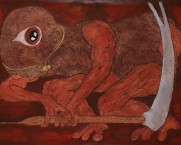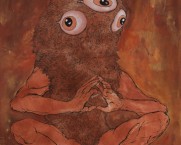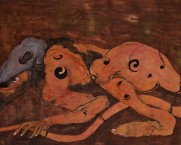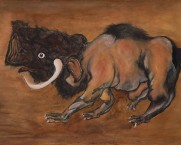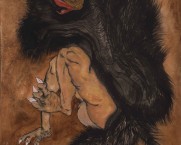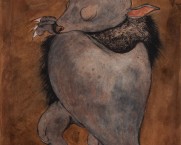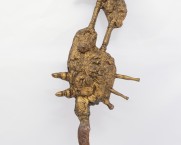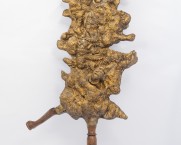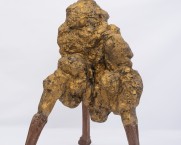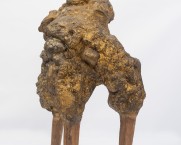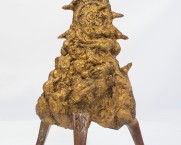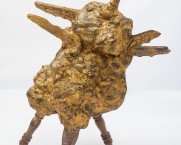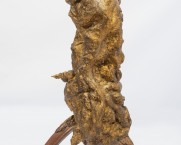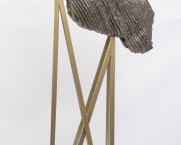C&L Shows
Juggernaut
Sahej Rahal
2019
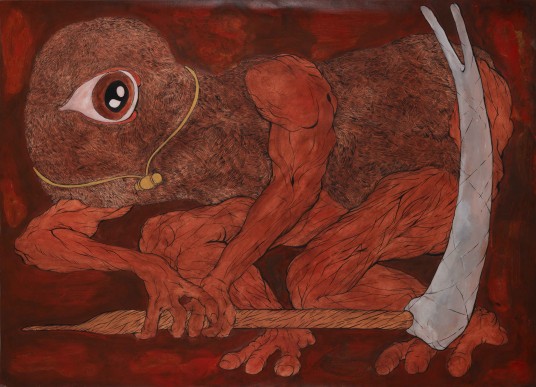
Overview
Juggernaut brings together Sahej Rahal’s paintings, sculptures, an AI programme, and a zine. Their creation is part of Rahal’s world-building, a practice that emerges from an interest in collecting and collaging detritus, and other found materials. This series of works draws from mythology, science fiction, illustrated manuscripts, and video games among other sources, and adds to a still unfolding meta-narrative.
The Terrain of the Juggernaut
There is no uncorrupted original. They crawl out one after another with borrowed limbs and do what only monsters can — issue warnings from elsewhere. There must be a Book of Wonders in the ruins of the library of the old empire that might yet draw one of those creatures in. There must be an apocryphal tale of a traveller from the North in which their detached shadows might still lurk. They emerge from the desire to speak about the vastness of this and every land. Their tools are weapons here, their ballads our prophecies.
It is said that when armies on both sides of the front use the language of deliberate distortion to win the information war, these creatures arrive with their myths. The golden objects they have brought here appear dormant but approach with caution for they bear the arms of the Invincible Goddess. They may wake up and learn the laws of this topography; they may grow and acquire an unexpected gait; and just as suddenly they may disappear into a parallel, virtual space. As any scholar of the end of colonisation will remind you, the Juggernaut is not simply what it is. The name bears the scars of the destruction of a world, lost to plunder and transformation.1
Juggernaut was once Jagannath, the lord of the universe. Of him, a missionary wrote after a sojourn in the East: “I have seen Juggernaut. No record of ancient or modern history can give, I think, an adequate idea of this Valley of Death.”2 And, then another, at the debut of the century they call the nineteenth, was reported to have broken into song following a peculiar encounter: “It creaks, and groans, and grinds along/ ’Mid shrieks and prayers—’midst dance and song/ With orgies in the eye of noon/ Such as would turn to blood the moon.”3 They say Juggernaut demanded sacrifice, that he was merciless and, moreover, unstoppable despite the depth of the sand around his chariot. Juggernaut came to be that miraculous force of movement that could trample everything in its way. Scribes today use the word to describe everything from the rise of right-wing groups, the glory of football players, to the success of companies that trade across nations.
Juggernaut is now Juggy, fleshy and with tentacles, inhabiting an otherworld. Juggy rolls across the desert, scaling violet rocks, tracing a new path at the beginning of each cycle, learning from its own actions. Parts of pillars that must have once belonged to an impressive structure attach themselves to Juggy. The pillars turn into appendages. Juggy grows and grows, dancing to a hypnotic beat. The Four Philosophers, who have spent over a decade crafting their ideas in the labyrinths of the Web, argue that objects can have an existence beyond human experience, that they can be things-in-themselves. The Four say that the practice of Speculative Realism is the only way to find an escape from Kant’s dungeon.4 Look at Juggy’s moves if you’ve ever asked yourself, “What is it like to be a thing?”5
Various states of animation could be possible in the sculptural fusion of fragments of smashed idols, legs that once held up grand tables, floral emblems of an unknown clan. These elements have found a messy equilibrium, an unknown purpose. However, we know what the Final Mother is here to offer in the Age of Capital. She is a representation of the fertility of the landfill, made of compressed plastic, worshipped by all looking for second chances. Yet, her layered body bears an unexpected resemblance to a terrain as old as time, a volcanic region that was formed 66 million years ago now known as the Deccan Traps.6 The archeologist Hamid Parsani may have been writing about the Final Mother when he was investigating something “recovered from a forsaken perpetuity, or the ‘Ancient Without Tradition.’”7
Be wary of the seduction of myth, and its potential to inspire a quest towards the original, the pure, the first. Fascism, the force that reigns, is another name for the turning of old plural myths into a unitary political mythology.8 They have made laws against all that they consider deformed and grotesque. They deny many belonging to the soil; they forbid movement across borders and planes. But the rebels are here, brown as the earth, of unlikely pedigree and uncertain affiliation. In their eyes, we see the reflection of the two moons and tornadoes. They are at once ancestors and progeny of the beasts chronicled in medieval manuscripts and tomes of Manga.
This is only one act among many. All that stands and moves here, however unpredictably, are the characters and vehicles of an ongoing meta-narrative. Their paths weave in and out of worlds that we know and yet others that we cannot fathom. They transport us towards another understanding of the present. They do not merely invite us to fantasy, or provide us a means of escape, but offer a confrontation with reality from a more advantageous position.9
~ Zeenat Nagree, 2019
Sahej Rahal (b.1988) has exhibited widely both in India and across the world, most recently mounting a major solo, The Dekkan Trap, at MAC, Birmingham, UK. He has participated in a number of prestigious group exhibitions including the Liverpool Biennale, 2016; the Setouchi Triennial, Japan, 2016; and the Kochi Muziris Biennale, 2014. Rahal is the recipient of a number of high profile awards and residencies.
Notes:
- An early critical study of the European disregard for Hindu art can be found in Partha Mitter, Much Maligned Monsters: A History of European Reactions to Indian Art (Oxford: Clarendon Press, 1977).
- Claudius Buchanan, Two Discourses Preached Before the University of Cambridge . . . To Which Are Added Christian Researches in Asia (Boston: Samuel T. Armstrong, 1811), 103, 105.
- Originally printed in the Maryland Gazette, 21, 28 Nov. 1822. Quoted in William Gribbin, “The juggernaut metaphor in American rhetoric,” Quarterly Journal of Speech, volume 59 no 3 (1973): 301-302.
- Speculative Realism refers to a range of allied positions on the non-human. The movement got its name from a conference featuring Ray Brassier, Graham Harman, Iain Hamilton Grant and Quentin Meillassoux, held at the Goldsmiths College, London, in April 2007. For a brief history, see Marc Fisher, “Speculative Realism,” Frieze, 12 May 2009. Quentin Meillassoux describes Speculative Realism’s opposition to post-Kantian philosophy as such: “…the central notion of modern philosophy since Kant seems to be that of correlation. By ‘correlation’ we mean the idea according to which we only ever have access to the correlation between thinking and being, and never to either term considered apart from the other.” Quentin Meillassoux, After Finitude: An Essay on the Necessity of Contingency, trans. Ray Brassier, (London: Continuum 2008), 2, 5.
- This question is the central focus of Ian Bogost, Alien Phenomenology or What It’s Like to Be a Thing (Minneapolis: University of Minnesota Press, 2012).
- Sahej Rahal’s most recent solo exhibition was titled The Dekkan Trap and was on view at The Midlands Art Centre, Birmingham, from 16 February to 22 April 2018.
- Hamid Parsani is the central character in Reza Negarestani, Cyclonopedia: complicity with anonymous materials (Melbourne: re.press, 2008), 15.
- “For Borges and Freud, fascism’s lack of truth was related to its unreason, its turning of old plural myths into a unitary political mythology.” Federico Finchelstein, “Truth, Mythology and the Fascist Unconscious,” Constellations, volume 23 no 2 (2016), 227. In 2014, Wendy Doniger’s The Hindus: An Alternative History was withdrawn from the Indian market following protests by Hindu nationalist bloggers and groups, primarily Shiksha Bachao Andolan (Save Education Movement).
- In a blurb on his book Dreamtigers, Jorge Luis Borges is described as such: “He does not venture into fantasy to evade reality but rather to confront reality from a more advantageous position.” Jorge Luis Borges, Dreamtigers, trans. Mildred Boyer and Harold Morland (New York: E.P. Dutton & Co, 1970).

